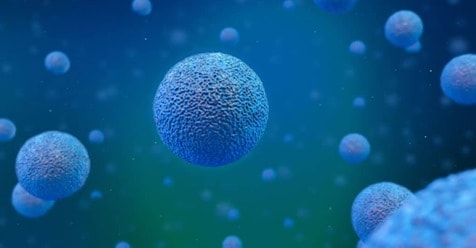
Exosomes are about 40 to 150 nanometers in size, around the same sizes as most viruses. All types of cells produce them. Exosomes are extremely plentiful—normal human blood is estimated to carry two quadrillion (2×1015) exosomes—and are found in abundance in all bodily fluids.
Exosomes vary greatly in their cargos, which include proteins, lipids, RNAs, and DNA. In many cases, it is possible to determine the type of cell that produced a particular exosome, based on its cargo.

Currently, most exosome research has addressed their role in cancers and to a somewhat lesser extent, HIV. Many in vitro and in vivo studies have shown that cancerous cells produce exosomes with certain proteins and microRNAs (miRNAs) being overexpressed with respect to healthy cells of the same type. Furthermore, abnormal cells produce many more exosomes than healthy cells do.
Exosome research has been focusing on several different roles that exosomes can and do play in the progression and treatment of diseases and other abnormal conditions. In cancer research, some exosomes have been found to promote tumor growth, while others act to suppress it. In HIV studies, exosomes that have been hijacked by HIV have been implicated in the spread of HIV to healthy T-cells—the so-called “Trojan Exosome Hypothesis.” In any case, the ubiquity of exosomes in many biological fluids and the potential to tie them to the cell types they originated from makes them ideal candidates for non-invasive diagnostic tools that can act as disease-specific biomarkers. Furthermore, since the number of exosomes a cell produces and the cargos they carry vary with the health status of the cell, the effectiveness of a treatment could be monitored by regularly analyzing blood serum or some other relevant fluid.
Our understanding as to how exosomes act to achieve communication and influence between cells is still in its infancy. Many scientists believe that as progress is made on this front, it will be possible to engineer the contents of exosomes so as to deliver therapeutic materials to diseased cells.
Exosomes have also caught the attention of psychiatrists and neurologists, for several reasons. First, miRNAs, many of which can only be easily obtained from exosomes, have been implicated in several brain disorders such as depression, schizophrenia, anxiety, and bipolar disorder, as well as affecting more general brain functions such as neuroinflammation, neurogenesis, interneuronal communication, and transcriptional regulation. Both the number of exosomes and their cargos can differ significantly between normal brains and those with impairments. As some studies have shown, miRNAs extracted from exosomes in plasma can function very effectively as biomarkers that can, for example, differentiate among controls, people with schizophrenia, and bipolar patients.
Second, exosomes can cross the blood-brain barrier (BBB) bi-directionally and tend to be ignored by the immune system. This implies that, in concept, exosomes can be engineered to deliver therapeutic drugs to the brain.
To date, there have been just a few studies looking specifically at autism and exosomes, and they have had limited scopes. One study reported that compared to 40 controls, 40 children with autism carried significantly more EVs in their serum and that these EVs contained greater amounts of mitrochondrial DNA (mtDNA). The authors also reported that in vitro EVs from the subjects with ASD stimulated human-cultured microglia to secrete the pro-inflammatory cytokine IL-1β.
However, several of the more general studies of the roles exosomes can and do play in brain disorders would seem to include autism without explicitly saying so. This is especially the case for studies that focus on neuroinflammation. Some studies have shown that exosomes not only cross the blood-brain barrier, but they can also affect the barrier resulting in a leaky BBB.
There are several avenues and opportunities for introducing exosomes into autism research. It seems reasonable that exosomes should initially be used to confirm and extend findings already established by other means. Existing banks of stored brain tissue and bodily fluids from controls and individuals with autism should be able to provide abundant sources of exosomes for such studies. Interested researchers can read the references below and do their own web searches for methodological details. It is critically important that any initial research using exosomes be carried out using data that has been properly truthed. Once the effectiveness of exosome-based research has been established, then we can turn to their diagnostic and therapeutic uses.
Suggested further readings are listed below. There are many other articles on the net that delve more deeply into the biology of EVs and their functions.
• “The biology and function of exosomes in cancer,” R. Kalluri, J Clin Invest. 2016; 126(4):1208-1215, https://doi.org/10.1172/JCI81135. This review article provides an overview of exosomes and then gets more specific about how the many roles that exosomes play can be used to detect cancers and to understand the biogenesis and microenvironments of tumors, and can perhaps be used in chemotherapy and immunotherapy.
• “The emerging role of exosomes in mental disorders,” S. Saeedi et al., Translational Psychiatry (2019) 9:122, https://doi.org/10.1038/
s41398-019-0459-9. This review article describes the state of the art in our knowledge of how exosomes are involved, in many ways, in synaptic plasticity, neuronal stress response, neuroinflammation, cell-to-cell communication, and neurogenesis. It describes, with excellent graphics, the many implications of exosomes being able to freely cross the blood-brain barrier. Much of what this article discusses applies to autism as well as the disorders addressed in the paper.
• “Differential expression of exosomal microRNAs in prefrontal cortices of schizophrenia and bipolar disorder patients,” M.G. Banigan et al., (2013). PLoS ONE 8(1): e48814. doi:10.1371/journal.pone.0048814. This article describes in great detail the process of extracting exosomes from stored brain tissue and their role in distinguishing controls from schizophrenia or bipolar disorder.
• “Extracellular vesicles are increased in the serum of children with autism spectrum disorder, contain mitochondrial DNA, and stimulate human microglia to secrete IL1β,” I. Tsilioni and T. Theoharides Journal of Neuroinflammation (2018) 15:239 https://doi.org/10.1186/s12974-018-1275-5. This article, referred to above, provides an excellent example of an experimental design using exosomes in autism research.
• “Stem cell-derived exosomes in autism spectrum disorder,” N. Alessio et al, Int J Environ Res Public Health, https://dx.doi.org/10.3390/
ijerph17030944. To quote from the abstract, “This review article describes the potential role of exosomes in alleviating ASD symptoms.” It claims, “Neuroinflammation and neuro-immune cross-talk are specific hallmarks of ASD.” Like other papers that examine the role of exosomes in all aspects of autism, this one is long on prediction and short on data. Nonetheless, it provides some useful biological information and some references that might be worth following.
Robert A. Rubin
Department of Mathematics,
Whittier College, Whittier, California
This editorial originally appeared in Autism Research Review International, Vol. 35, No. 2, 2021
ARI’s Latest Accomplishments
Connecting investigators, professionals, parents, and autistic people worldwide is essential for effective advocacy. Throughout 2023, we continued our work offering focus on education while funding and support research on genetics, neurology, co-occurring medical
Biomarkers start telling us a story: Autism pathophysiology revisited
Learn about emerging research on biomarkers and autism from a recent ARI Research Grant recipient. This is a joint presentation with the World Autism Organisation. The presentation by Dr.
Editorial – Bernard Rimland’s Impact: Sixty Years Since the Publication of ‘Infantile Autism’
In this milestone year of 2024, the Autism Research Institute commemorates the 60th anniversary of Dr. Bernard Rimland’s groundbreaking work, Infantile Autism: The Syndrome and Its Implications for a Neural Theory of




